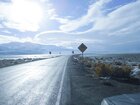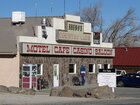 Those of you who have read the complete Frank Adversego canon may recall that in The Lafayette Campaign our hero came close to attending the Burning Man Festival. The following describes my own near miss in 2005.
Those of you who have read the complete Frank Adversego canon may recall that in The Lafayette Campaign our hero came close to attending the Burning Man Festival. The following describes my own near miss in 2005.
If you consult an on-line map of Nevada, you’ll see that its upper left quarter is bounded on the south by Interstate 80 and on the east by Route 140. And inside that box, nothing, unless you keep zooming in. Eventually, you’ll find just a few more roads. If you were to turn on to any of them you would almost certainly find yourself driving on gravel at best, and rutted clay or deep, car-trapping sand at worst.
Leaving aside for the moment why you might wish to, let’s assume you’ve arrived in Reno with the object of visiting this consummately empty landscape. Thirty-four miles east of the capital of Nevada, you’ll want to turn north on state route 447 at the town of Fernley; the road will be paved there but will eventually surrender that extravagance in favor of gravel. When it does, go light on the gas. Otherwise, one of those sharp pieces of crushed stonewill eventually work its way up between your tire treads, leaving you changing a tire by the side of the road. But never mind, in only seventy-eight more miles you’ll reach your destination, the only town within a similar distance in any direction.
Back in 2005, Gerlach boasted a cosmopolitan four hundred fifty citizens. Or, as one guide summarized it:
Welcome to Gerlach, Nevada (pop. 450). In this thriving metropolis you will find one elementary school, one high school, one post office, one propane distributor, one gas station, one motel, 3 bars and that’s it.
Since then, the population has dwindled to a mere hundred and seven. But that’s enough to make Gerlach the hub of an area the size of Connecticut with only a handful of isolated ranches scattered like buckshot across the arid terrain.
 When you arrive, you’ll want to gas up, and (if you didn’t heed my hard-earned advice above) have that tire repaired. When I did the same back in 2005, that meant stopping at Bruno’s Texaco. Bruno is obviously the local commercial baron, with an empire that includes a multi-purpose emporium called Bruno’s Country Club. In the back of the gas station, I found a photo tacked to the wall. In that photo, the owner was holding up the head of a mountain sheep with more than a full 360-degree curl of horn. Far behind and below the pictured hunter I could see Gerlach. Probably Bruno’s Texaco as well, if I’d looked hard enough. You have to be pretty isolated to shoot a mountain sheep in your own extended back yard.
When you arrive, you’ll want to gas up, and (if you didn’t heed my hard-earned advice above) have that tire repaired. When I did the same back in 2005, that meant stopping at Bruno’s Texaco. Bruno is obviously the local commercial baron, with an empire that includes a multi-purpose emporium called Bruno’s Country Club. In the back of the gas station, I found a photo tacked to the wall. In that photo, the owner was holding up the head of a mountain sheep with more than a full 360-degree curl of horn. Far behind and below the pictured hunter I could see Gerlach. Probably Bruno’s Texaco as well, if I’d looked hard enough. You have to be pretty isolated to shoot a mountain sheep in your own extended back yard.
All that isolation changes once a year, when the Burning Man countercultural festival brings tens of thousands of folks out into Black Rock Desert, one of the endless alkali lake beds that firm up after the snow melt sinks into the playa and the temperatures climb through the roof, spinning dust devils aimlessly off into the middle distance. Once, these lakebeds were part of an enormous, post-glacial sea. Only Pyramid Lake remains today, fifty miles to the south, with its impossibly blue waters and surreal flocks of white pelicans interrupting the earth tones of the desert stretching away into infinite distance.
Although I was not aware of it at the time, the advent of the Burning Man festival was nigh, and the hustle and bustle that would attend that transformation was just kicking off. The way I described it in The Lafayette Campaign was pretty much what it looked like that day in August:
Temporarily there was more to Gerlach, because the Festival was about to begin. Spread along the roadside and in the parking lots of the few dusty buildings that together comprised downtown Gerlach was a line of brightly hued, open wall tents selling water, food, balloons, happy face condoms, mountain bicycles, and almost anything else that you might (or might not) expect a festival-goer to want or need. Colorful pennants fluttered in the breeze above a throng that would blend in well in Key West on New Year’s Eve, only wearing even fewer clothes.
Less frequently, Gerlach has garnered fleeting fame when new daredevils (for who knows what reason) set their sights on breaking the land speed record, hurtling in fighter jet engine-powered – and even rocket-powered – wheeled missiles across a landscape that must be pool-table smooth and devoid of the smallest stone to protect these gargantuan, screaming suicide sleds from cartwheeling into a disintegrating cloud of shrapnel. Decades ago, when Craig Breedlove was blowing out the old records, these time trails were held on the Bonneville Salt Flats. When unexpected rains rendered that site soggy, the effort was moved to Black Rock Desert and stayed there, culminating in the triumph of a British team in 1997, when, for the first time, a vehicle without wings broke the speed of sound, the driver strapped into a tiny cockpit dwarfed by the two enormous jet engines it was sandwiched between.
But the rocket racing days are gone, at least for now. In their place, there is Burning Man, and at the time of my arrival the big event was only a few days away; as I motored slowly along commercial advance teams were setting up their tents alongside of what passes in Gerlach for a main street. A few miles outside of town on my way north the road briefly touched on the edge of the great salt flat, silent and waiting for the emergence of a sprawling, ephemeral city that would disappear just as suddenly a week hence, leaving nothing behind but the ashes of a giant, wooden, conflagrated colossus.
Then, up ahead, I saw a pillar of dust climbing into the sky. At it’s base, the dust boiled up and sprayed off to the side. I slowed down to better see what might be speeding so forcefully towards Gerlach. Soon, the blunt muzzle of a tractor trailer became visible, and then not one but three juggernauts were upon me, each with a full load.
To my surprise, the trucks crossed my lane and hurtled out onto the playa, raising a storm of white alkali dust that mushroomed and swirled high up into the air. As the caravan thundered off into the heat-shimmering void of the salt flat, I craned my neck to see what it was that needed to be delivered to the middle of an alkali lake before a temporary city could rise.
The answer, of course, was obvious. Each truck was stacked five wide and two deep with Porta-Potties in most of the colors of the rainbow.
The time for Burning Man had clearly come again.
August 17, 2005
If you’d like to read future posts in this series, be sure to provide your email address in the upper right corner of this page and check the “Email notice of blog entries” box.

Follow Us!